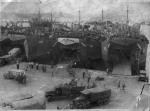NavSource Online: Amphibious Photo Archive
LST-302

LST-302 was transferred to the United Kingdom for the duration of World War II
Please report any broken links or trouble you might come across to the Webmaster. Please take a moment to let us know so that we can correct any problems and make your visit as enjoyable and as informative as possible.

Royal Navy History Commissioned into the Royal Navy as HM LST-302, 14 November 1942 Sailed from New York as part of 1st Flotilla, 27 January 1943 but had to return Sailed again, 23 February 1943 for the Mediterranean via Bermuda HM LST-302 was assigned to the Europe-Africa-Middle Theater and participated in the following campaigns:
Campaign and Dates Campaign and Dates Sicilian occupation, July-August 1943 (probably) West Coast of Italy operations-1944
Anzio-Nettuno advanced landings, February to March 1944Salerno landings
(MacDermott, Ships Without Names probably Salerno), September 1943Invasion of Normandy, June 1944 Various repairs after the Invasion of Normandy at Leith, Southampton, Thames, Dundee and the Clyde Paid off and returned to US Navy custody at New York, 5 January 1946
| Click On Image For Full Size Image |
Size | Image Description | Source | |
|---|---|---|---|---|
 |
79k | HM LST-302, HM LST-303 and USS LST-349 at Nisida, Italy, while loading or unloading equipment, date unknown. | Robert Hurst and Brian Keniry | |
 |
125k | HM LST-302 alongside the "Captain" - class frigates HMS Trollope (K-575) (center) and HMS Lawford (K-514) dockside, in Portsmouth Dockyard, 26 May 1944. Imperial War Museum photo #: 25517 from "The Captain Class Frigates in The Second World War," by Donald Collingwood. |
Robert Hurst | |
| Back To The Navsource Photo Archives Main Page | Back To The Amphibious Ship Type Index | Back To The Tank Landing Ship (LST) Photo Index |
| Comments, Suggestions, E-mail Webmaster. |
|
This page is created by David W. Almond and maintained by Gary P. Priolo |